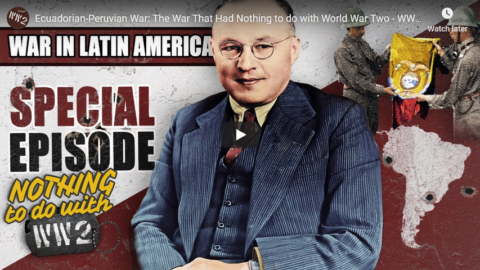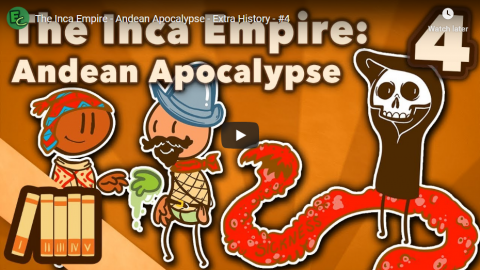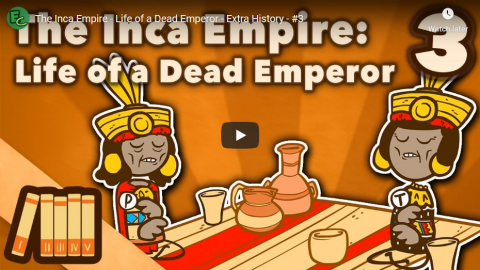World War Two
Published 10 Sep 2020While the Second World War grows ever more destructive, some nations take advantage of the global chaos to settle old disputes. In Peru and Ecuador, long standing territorial disputes turn violent.
Join us on Patreon: https://www.patreon.com/TimeGhostHistory
Or join The TimeGhost Army directly at: https://timeghost.tvFollow WW2 day by day on Instagram @ww2_day_by_day – https://www.instagram.com/ww2_day_by_day
Between 2 Wars: https://www.youtube.com/playlist?list…
Source list: http://bit.ly/WW2sourcesHosted by: Indy Neidell
Written by: Francis van Berkel
Director: Astrid Deinhard
Producers: Astrid Deinhard and Spartacus Olsson
Executive Producers: Astrid Deinhard, Indy Neidell, Spartacus Olsson, Bodo Rittenauer
Creative Producer: Joram Appel
Post-Production Director: Wieke Kapteijns
Research by: Marlon William Londono and Lewis Braithwaite
Edited by: Mikołaj Cackowski
Sound design: Marek Kamiński
Map animations: Eastory (https://www.youtube.com/c/eastory)Colorizations by:
Carlos Ortega Pereira, BlauColorizations, https://www.instagram.com/blaucolorizations
Mikolaj UchmanSources:
David Rumsey Map Collection, David Rumsey Map Center, Stanford Libraries
ecured.cu
From the Noun Project: Artillery by Creative Mania, engineer by Eucalyp, company soldiers by Andrei Yushchenko, Horse by RIZCASoundtracks from the Epidemic Sound:
Rannar Sillard – “March Of The Brave 4”
Johannes Bornlof – “The Inspector 4”
Fabien Tell – “Last Point of Safe Return”
Reynard Seidel – “Deflection”
Philip Ayers – “Trapped in a Maze”
Johannes Bornlof – “Deviation In Time”Archive by Screenocean/Reuters https://www.screenocean.com.
A TimeGhost chronological documentary produced by OnLion Entertainment GmbH.
September 11, 2020
Ecuadorian-Peruvian War: The War That Had Nothing to do with World War Two – WW2 Special
September 16, 2019
The Inca Empire – Andean Apocalypse – Extra History – #4
Extra Credits
Published on 14 Sep 2019Join us on Patreon! http://bit.ly/EHPatreon
Disease — likely, smallpox or measles — had arrived in the Inca empire, and it was ruthless. Two of the (now dead) Emperor Huayna Capac’s sons, Atahualpa and Huáscar, decided that a civil war over who should be Sapa Inca was perfect to do right now — nevermind the fact that Francisco Pizarro and his conquistadores had just showed up.
September 9, 2019
The Inca Empire – Life of a Dead Emperor – Extra History – #3
Extra Credits
Published on 7 Sep 2019Join us on Patreon! http://bit.ly/EHPatreon
To understand daily life in the Inca Empire, we travel from Cusco to Quito (located in modern-day Ecuador), where Thupa Inca wanted to establish a second capital city. From efficiently designed work assignments, to elaborate death rituals, life was neatly organized, masking rising tensions.
June 28, 2013
Ecuador responds to US diplomatic pressure by abandoning trade agreement
This is either political grandstanding for foreign audiences or a shrewd attempt to gain some positive domestic points:
One of the points that many people have made concerning most countries in the world is that they’re loathe to challenge the US on many things, even when they’re in the right, because they’re so reliant on the US for trade. The US regularly lords this fact over countries in seeking to get its way. In fact, US officials had been very strongly suggesting to Ecuador that if it decides to take in Ed Snowden and grant him asylum, that there could be consequences for trade under the Andean Trade Preference Act that both countries are signed to, but which needs to be renewed next month. Specifically, US politicians suggested that they might not allow the renewal if Ecuador granted asylum.
In response, Ecuador has taken a stand: saying that it’s breaking the trade agreement upfront as it doesn’t appreciate the attempt by the US to blackmail it in this matter.
[. . .]
As the article notes, some of this is surely political. It is a bit of a populist move by the government, and many suspected that the trade agreement was unlikely to be renewed anyway by the US, so in some ways this is an attempt to get out in front of that story and pull something of a “you can’t fire me, I quit!” move. Still, it highlights, once again, the way the US bullies smaller countries, and how that can backfire.
June 23, 2013
Ecuador press law to mandate coverage of government propaganda items
Ecuador has a new law on the books that may force the media to carry government propaganda or risk prosecution:
Under Ecuador’s new Communications Law, however, journalists may have to pay far more attention to ribbon-cutting ceremonies and other government PR events. Article 18 of the law forbids the “deliberate omission of … topics of public interest.” But this wording is so vague that nearly any action by local, state, or national government official could be considered of public interest.
“Newspapers don’t have enough journalists or space to cover all these events. Radio programs don’t have enough air time,” Paúl Mena, president of the Ecuadoran Journalists’ Forum, told CPJ. “If the government starts demanding coverage, there are going to be problems.”
More conflict between the media and the Correa government seems inevitable under the Communications Law, which was approved by the National Assembly on June 14 and will go into effect next month. Not only does the law create a state watchdog entity to regulate media content, but it is filled with ambiguous language demanding that journalists provide accurate and balanced information or face civil or criminal penalties. “This is completely crazy,” Monica Almeida, an editor at the Guayaquil daily El Universo, told CPJ. “The law is designed to regulate everything we do.”
[. . .]
The 44-page law contains 119 articles. In interviews with CPJ, Ecuadoran journalists were at a loss to pick out the worst provisions since they view nearly all of them as serious violations of press freedom.
For example, under the law reporters are now required to earn a journalism degree. Rather than serving as a neutral referee, the Superintendence of Information and Communication — the government’s new watchdog agency — could be used by Correa to simply bash the press. And reporters are especially incensed by Article 26 that prohibits “media lynching.” This is defined as “the dissemination of concerted and reiterative information … with the purpose of undermining the prestige” of a person or legal entity. Media outlets found violating this provision could be ordered to issue public apologies and would be subject to criminal and civil sanctions that are not specified in the legislation.
One magazine editor in Quito, who asked to remain anonymous, said the article seems designed to thwart investigations. That’s because such in-depth reporting often requires publishing a series of stories over several days or weeks that could be construed as harassment.
September 13, 2012
Submarines for the drug trade
The drug gangs in south and central America are becoming quite sophisticated in their attempts to get their products to the eager US consumer. One of the more technological developments is the drug-running submarine:
Despite losing nearly a hundred of these vessels to U.S. and South American naval forces (and dozens more to accidents and bad weather) the drug gangs have apparently concluded that the subs are the cheapest and most reliable way to ship the drugs. It’s currently estimated that over 80 percent of the cocaine smuggled into the United States leaves South America via these submarines or semi-submersible boats.
Most of these craft are still “semi-submersible” type vessels. These are 10-20 meter (31-62 foot) fiberglass boats, powered by a diesel engine, with a very low freeboard, and a small “conning tower” providing the crew (of 4-5), and engine, with fresh air and permitting the crew to navigate. A boat of this type was, since they first appeared in the early 1990s, thought to be the only practical kind of submarine for drug smuggling. But in the last decade the drug gangs have developed real submarines, capable of carrying 5-10 tons of cocaine that cost a lot more and don’t require a highly trained crew. These subs borrow a lot of technology and ideas from the growing number of recreational submarines being built.
[. . .]
The submarines that have been captured have, on closer examination, turned out to be more sophisticated than first thought. The outer hulls are made of strong, lightweight Kevlar/carbon fiber that is sturdy enough to keep the sub intact but very difficult to detect with most sensors. The hulls cannot survive deep dives but these boats don’t have to go deep to get the job done. The diesel-electric power supply, diving and surfacing system, and navigational systems of captured subs was often in working order. It was believed that some of those who built these boats probably had experience building recreational subs. The sub builders also had impressive knowledge of the latest materials used to build exotic boats. It had already become clear that something extraordinary was happening in these improvised jungle shipyards.
Ecuadoran police found the first real diesel-electric cocaine carrying submarine two years ago. It was nearly completed and ready to go into a nearby river, near the Colombian border, and move out into the Pacific Ocean. The 23.5 meter (73 foot) long, three meter (nine feet) in diameter boat was capable of submerging. The locally built boat had a periscope, conning tower, and was air conditioned. It had commercial fish sonar mounted up front so that it could navigate safely while underwater. There was a toilet on board but no galley (kitchen) or bunks. Submarine experts believed that a five man crew could work shifts to take care of navigation and steering the boat. The boat could submerge to about 16 meters (50 feet). At that depth the batteries and oxygen on board allowed the sub to travel up 38 kilometers in one hour, or at a speed of 9 kilometers an hour for 5-6 hours. This would be sufficient to escape any coastal patrol boats that spotted the sub while it moved along on the surface (its normal travel mode). The boat could also submerge to avoid very bad weather. The sub carried sufficient diesel fuel to make a trip from Ecuador to Mexico. There was a cargo space that could hold up to seven tons of cocaine.
August 17, 2012
Even Guardianistas are puzzled by Assange’s Ecuador gambit
There are few newspapers who have been as supportive of Julian Assange in his legal plight than the Guardian. When even Guardian columns find it difficult to figure out why he turned to Ecuador, we’ve moved into a different universe:
Julian Assange’s circus has pulled off another breathtaking stunt: he has won political asylum in Ecuador. Assange’s flight from Sweden, a decent democracy with a largely excellent justice system, takes ever more absurd forms. After the decision of Ecuador’s foreign minister, Ricardo Patiño, the Swedish Twitterverse filled with mocking jokes.
Assange has few fans left here. On the contrary, his unholy alliance with Ecuador’s political leadership casts a shadow over what was, despite everything, his real achievement: to reveal shattering news through the revolutionary medium of WikiLeaks.
Patiño praised Assange as a fighter for free expression, and explained that they had to protect his human rights. But Ecuador is a country with a dreadful record when it comes to freedom of expression and of the press. Inconvenient journalists are put on trial. Private media companies may not operate freely.
President Rafael Correa is patently unable to tolerate any truths that he does not own. Reporters Without Borders has strongly and often criticised the way that media freedoms are limited in Ecuador. Assange is a plaything for the president’s megalomania.






